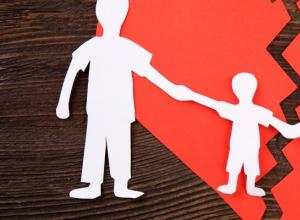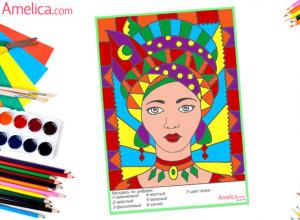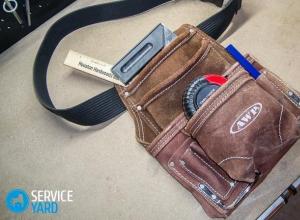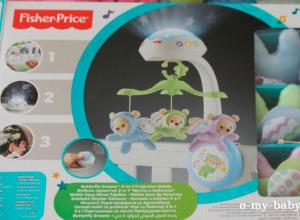Master class on making a paper train. Do-it-yourself train: creating a craft for children from unusual materials Drawing of a train carriage from paper for crafts
“Making a train from colored paper with your own hands.” Master class with step-by-step photos
Degtyartseva Natalya Vasilievna, teacher of MAU DO DDTT
Vladikavkaz, North Ossetia - Alania
The work is intended for children aged 7 years and older, teachers and parents.
Purpose: toy, interior decoration, gift for family and friends, exhibit for an exhibition of technical creativity.
Target: make a train from colored paper with your own hands.
Tasks: educational - master the technique of making a steam locomotive and trailer; developmental - to develop practical skills of students when working with scissors, to develop fine motor skills, imagination and imagination of the child; educational - to cultivate aesthetic taste.
Materials and tools: colored paper, scissors, glue, ruler, pencil, eraser, compass.

Riddles for children.
The brothers are ready to visit,
They clung to each other,
And they rushed off on a long journey,
They just left some smoke.
(Train)
Far, far away
Along the railway
Maybe this guy
Take away the entire village.
(Train)
Behind the smoke
Behind the whistle
The brothers run in single file.
(Wagons)
V. Struchkov
The Iron Snake is crawling
It carries passengers into the distance.
(Train)
Iron Snake
It meanders in the steppes.
Lost in the steppes.
The voice is clear
Runs after the drifting snow.
I ran a thousand miles.
She unhooked the long tail.
Fifteen Brothers
They love to ride.
The first one with a pipe
Leads everyone with him.
(Train)
One hundred barrels
Gudochek leads.
(Train)
Steel Mare
It rushes across the azure steppes.
Ran a hundred miles
She unhooked the long tail. (Train)
Along steel tracks
The Centipede rushes.
Knock-knock-knock.
Round heel clicks.
With a funny song
Along the iron ladder.
(Train.)
V. Tunnikov
Back and forth every day
Carries loads carefully.
In rain, snowstorm, heat, frost
The hard worker rushes - ... (locomotive)
Step by step process of making a train.
Making a steam locomotive.Stepping back 1 cm from the narrow edge of the A4 sheet, fold the sheet on both sides of the ruler. Place the ruler with its left edge on the second bend and bend it again. Let's make four bends in this way.

Having received four wide strips, cut off the excess part of the sheet along the last bend. Fold the edge of the sheet, moving 1 cm from the left edge, and then fold the sheet on the other side of the ruler.

Cut off the excess paper, leaving a 1cm margin for gluing in the middle square. Cut the edges of the square to the line, as shown in the photo.

Glue the sides of the square together. Let's shorten the main part of the locomotive cabin by cutting it to the width of a ruler on the right side of the part.

Glue the edges of the long strips together to form a column. Glue the roof to the post. The locomotive cabin is ready.

To make a window, prepare a square with a side of 2.5 cm from colored paper, and a square with a side of 1.5 cm from white paper. For the door, cut out a 7x2.5cm rectangle and a 1cm strip for the handle. For the front part of the locomotive, we will bend a square with a side of 4 or 5 cm, moving 1 cm from the edge at the top and bottom. We cut the folded parts of the sheet for gluing.

Glue the prepared square into a tube. We will glue a window and a door onto the cabin of the locomotive.

Glue a colored strip 1.5cm wide onto a 6x5cm rectangle. On the previously prepared wide pipe we glue strips 0.5 cm wide along the edges.

Glue a small pipe in the center of a large pipe. We glue the large pipe, bending the edges, to the cabin of the locomotive. Glue a square-shaped piece of paper onto the free edge of the large pipe.

Let's make a strip 3x7cm. Use scissors to twist the edges of the strip in different directions, making a figure eight.

Let's make circles for wheels with a radius of 1.5 cm and 0.7 cm.

Let's cut off the extra edges of the square on the large pipe of the steam locomotive, glue the wheels and figure eight, as shown in the photo. The locomotive is ready.

Manufacturing of a carriage.
Stepping back 1cm from the top edge, fold the sheet on both sides of the ruler. Then the sheet on both sides, placing a ruler on the right and left of the edge of the sheet. Cut the bottom of the sheet to the width of the ruler. To do this, draw a line at the bottom of the sheet. Let's make cuts as shown in the photo.

From the second similar sheet we will leave only the middle part, cutting off the extra bends, as shown in the photo.

Cut small rectangles from the sides of the first part.

Glue the side parts on the first part, as shown in the photo.

Glue the second piece to the top of the first piece.

Glue the side parts of the car to each other.

Let's make a 11x5 cm rectangle for the door and two 7x5 cm rectangles for the windows. From white paper we will make a 3x6cm rectangle for the door window and two rectangles for the carriage windows
3.5x5.5cm. Let's make a 1.5 x 9 cm strip to indicate the direction of the train.

Let's glue the door and window parts to the car.

We will make six wheels according to the previously proposed model. The diameter of the large circle is 5 cm, the small one is 3 cm. Glue the wheels along the edge of the car and in the middle. The carriage is ready.

Let's glue the car to the fastening eight on the locomotive.

Our train is ready.
Tell your friends about this:
A passenger carriage is designed to transport people. It is built of metal, the interior is decorated with valuable wood, plastic, artificial leather, it has good ventilation, electric lighting, a radio, and a service compartment. The seating areas can easily be converted into sleeping areas. The carriages are painted predominantly green, sometimes dark red. They have good shock absorption, so there is no unpleasant shaking while driving. Passenger cars are mounted on two two-axle bogies. For the model, paper is used taking into account the traditional painting of the cars.
The proposed model has been simplified, the roof structure has been changed to make work easier. First, the end walls of the car are prepared, then the body is cut out, and folds are made along a ruler. The roof is made from a wide strip of paper; a small fold is made in the middle, along the long side. Installation is not difficult. End part valves
smeared with glue and attached to the walls of the car, then the roof is glued. The car is mounted on two two-axle bogies, which are prepared in advance. The finished model is produced
finishing (Fig. 99).
Tatyana Gurova
The wheels are knocking, knocking,
Our the train rushes into the distance,
And the smoke from the locomotive -
Whitish veil.
Half the sky closed from us,
And the steam locomotive “Tutu-tu,”
It buzzes, “I’ll be here before lunch.”
I'll bring the kids.
I'll arrive at the station,
Without delay, on time,
Then I'll go to the depot,
And I'll sleep there for an hour"
I. Shevchuk
Take a sheet paper A4 format and fold in half

Then, unfold the sheet and bend both sides towards the middle

Form a rectangle and cut it out of the strip paper window, paste

Then we cut out the circles and also glue them on.

That's it, one trailer is ready. Other trailers are made using this principle.

When we did train, the guys cut out the windows themselves from strips paper, and the wheels are made of squares.

Publications on the topic:
A path runs through the meadow, dives to the left, to the right. Everywhere you look, there are flowers all around, and knee-deep grass. Green meadow, like a wonderful garden, fragrant and...
Making flannelgraph. Master Class. Lushnikova M.V. – teacher. I have long wanted to have a flannelgraph in my group, but I had to get plywood.
Late autumn has arrived. The earth was covered with an autumn carpet. This inspired me to create an autumn gramophone and write a poem Poem.
GOAL: development of creative musical abilities in children. OBJECTIVES: - to give an initial idea of the wide possibilities of noise.
For work you will need: scissors, colored crepe paper, a glue brush, glue, black cardboard, cardboard for a template, a board, a stick.
The train is a frequent character in children's fairy tales and cartoons, a favorite hero of many kids. That is why mothers who do needlework often make crafts in the form of a colorful train. Such a product can be made from various materials, from almost all that surround us. For example, from felt, from photographs and even from boxes that are lying around on your balcony. Such crafts can be done with children; it will have a wonderful effect on their mood and hand motor skills. Thanks to this master class you will learn how to make a train with your own hands.
Option from diapers
Young mothers will definitely appreciate such a gift, because diapers are always useful when there is a one-year-old child in the house.
Necessary materials:
- diapers (20 pcs.);
- elastic cord;
- rubber bands for money (22 pcs.);
- corrugated paper;
- skewer;
- satin ribbons;
- stapler;
- glue;
- pins.
To begin, roll the diapers into a tube.
To prevent them from unwinding, secure them in the middle with an elastic band for money.

Make sixteen tubes.


Tie two tubes together, then attach the next ones to them, wrap each one in a circle.
On a note! If you just tie them with an elastic band, they will curl up and will not lie flat and neat.

Then press the cardboard on top of the diapers so that the outermost diaper does not lift up.

We tie it with a ribbon. You can use any tape as it will not be visible.

Let's move on to the frame of the locomotive. Tie two pairs of tubes together with rubber bands and place them on crepe paper.

Pack the diapers in paper and glue or staple the seams. Then cut the cardboard so that it does not stick out from under the frame. Secure it with ribbons, first trying it on the wheels.


Make a pipe for our locomotive. Wrap one diaper in crepe paper and glue it on top and at the seams. Insert a tube from a sheet of office paper inside the diaper. It can be replaced with a skewer.

Using a narrow knife, make a hole in the paper between the two diapers and insert the tube.

To make a train cabin, fold four diapers in half and stack them on top of each other.

Wrap in paper.

Place the cabin on the locomotive and secure with pins or glue.

For the carriage, make two pairs of knitted diapers. If desired, you can make trailers from cardboard.

Wrap in paper.

Make another trailer, but smaller. Secure all parts with satin ribbon. The diaper train is ready!

Thomas the Tank Engine
"Thomas the Tank Engine" is a popular modern cartoon that many children adore. Thomas is made from many materials: from mastic, from candies, and also from paper. We will consider the latter option.
"Dedicated to the crazy people"
If your desires to build a model railroad exceed the capabilities of mass production, it’s time to think about making your own models. There are different materials and technologies - here we consider manufacturing from cardboard.
First of all, you should stock up on everything you need.
First you need good white cardboard (preferably 0.35 - 0.5 mm - determined by eye using a ruler).
You also need the right tools:
- mechanical pencil with a 0.5 mm lead,
- PVA glue,
- ruler 30 cm,
- corner,
- eraser,
- threads (preferably not very fleecy),
- transparent plastic, double-sided tape,
- two types of emery (coarse and fine),
- paper knife, regular scissors,
- manicure scissors,
- clothespins (preferably plastic with flat surfaces),
- and also some other little things, which will be discussed below.
And most importantly, you need a sincere desire to make a layout!
Here we will consider the production of a model on a ready-made chassis. As a donor, you can use cars from the TT-model or VTTV.
When producing any model, reference materials are required in the form of drawings and illustrations of the modeling object. To save time, I also used the DMV from the TT model.
So, let's begin. If a drawing is used, then all dimensions must be recalculated to the appropriate scale, in my case - 1:120. Next, on a sheet of cardboard, you should draw a basic layout of the car WITHOUT a roof (the result should be an elongated parallelepiped without a floor) ( Rice. 1).

On it we draw everything that should be on the walls of the car, i.e. windows, doors, lines where there should be stiffeners, etc. After everything is drawn, we cut through all the windows with a knife.
Now it is necessary to increase the rigidity of the future body– on the back side you need to glue a second layer of cardboard with already cut windows onto the walls so that the windows coincide with each other ( Rice. 2).

Since cardboard has a bad tendency to swell when wet, you don’t need to spread a lot of glue, but quickly and thinly spread one side and immediately press it firmly and put it under a press.
Now let's deal with the stiffeners. They are made from threads that are glued along the drawn lines: first, an adhesive strip is applied, onto which the thread is then applied and pressed with a finger. The idea is to saturate the thread with glue and remove excess glue from the surface. Once all the ribs are glued on, it's time to outline the doors. To do this, cut a thin groove along the contour of the door with a knife. After this, we coat the cut out contours of the doors and the already glued threads. When everything has dried, you need to carefully walk over the surface of the threads with fine sandpaper and coat it with glue again. During all coatings, we try to leave as little glue as possible so that unnecessary irregularities do not come out later. Handrails are made from thin strips of cardboard.
Now it's time to start assembling. We press down the folds on the reverse side with scissors. Then we cut it out, carefully bend it and glue it together ( Rice. 3).

Carefully sand the rough protruding cardboard in the gluing areas.
Roof. To get the roof of the desired shape, you first need to create a parallelepiped from layered cardboard, the height of which is equal to the height of the roof itself (usually painted gray). The width and length should be 1 and 2 mm greater than the width and length of the car blank, respectively (these are approximate figures). This is necessary so that after gluing the roof (by the way, it is also advisable to glue it using a press), it can be sanded on the sides and thereby adjusted to the size of the car. Next, the roof needs to be given a convex shape - to do this, draw the roof profile from the ends and cut off the excess longitudinally. After this, we sand first with coarse sandpaper, and then with fine sandpaper. After this, coat the roof with glue and wait until it dries. We process with fine sandpaper and repeat the operation. Now you can glue the roof. If you can find something to hold it down with while it dries, that will be good. If the original has stiffening ribs on the roof, they are made in a similar way using threads. We coat the junction of the roof with the body with glue. After this, air intakes can be attached to the roof. We glue cardboard at the ends of the car to hide the joint, although, depending on the situation, you can do without it. Using toothpicks, transitional soufflés are made ( Rice. 4).

Let's talk a little about the insides. First you need to make a floor from 2-3 layers of cardboard. Next, we mark on it a diagram of the partitions, which, after cutting, we “put” on glue. The total height of the interior with the floor should be selected taking into account the height of the chassis. We glue the upper shelves to the walls, but the lower ones will most likely have to be glued to the floor. After this, a strip of cardboard 1 cm wide and 2 cm long less than the length of the car is glued on top of the partitions.
Now you can paint. It is advisable to use water-indelible paints. You can use aerosol, regular oil or special model paints. Next we use tape and brushes of different sizes to obtain the desired color.
When everything is dry, we glue strips of transparent plastic on the inside of the walls of the car using double-sided tape. From the inside, we stick double-sided tape onto the roof, and then press the insides of the car to it. We again glue double-sided tape to the floor of the car from below and press the chassis to it ( Rice. 5).


The car is ready!
Watch also the video on how to make a freight car out of cardboard.
Latest site materials
Experience

Maternity leave: what is meant by it?
Every expectant mother should have complete information on how and when to go on maternity leave. Such matters need to be organized in advance and not rushed, and many women simply do not know how many weeks they go on maternity leave in 2016. Most have heard more than once
Health

Statement of claim for divorce In what cases is a claim for divorce filed in court?
Family legislation in Russia establishes freedom for citizens in matters of marital relations. There is no legal norm prohibiting divorce, even with children. However, due to circumstances, the procedure for terminating family relations between citizens
Health

Kids games Coloring by numbers for kids online
In this section you can print coloring by numbers for children aged 4, 5, 6, 7 years. This is a more complicated version of coloring books containing more picture elements and colors. Coloring pages have a variety of themes: animals, birds, fish, flowers, plants and fairy tales
Experience

How to properly perm your hair at home?
Perm is a special procedure of applying chemicals to the hair, affecting its natural structure. The fact is that in cross section, curly hair is an oval, and straight hair is a circle. The purpose of perm is to change such a
Cosmetology

Tool bag - what should be in it?
Many men have faced the problem of storing, carrying tools and ease of use. Of course, you can buy a tool bag in a regular store, but it will be much nicer if you make it yourself. Yes, and in this case you l
Cooking

Mobile from Fisher Price “Dreams of Butterflies”
When my baby was born, I didn’t even think about buying a mobile phone. I thought that my son would not be interested in listening and watching. But I saw my godmother have a very beautiful carousel on her daughter’s crib, the daughter was very interested in the toy, and I wanted it